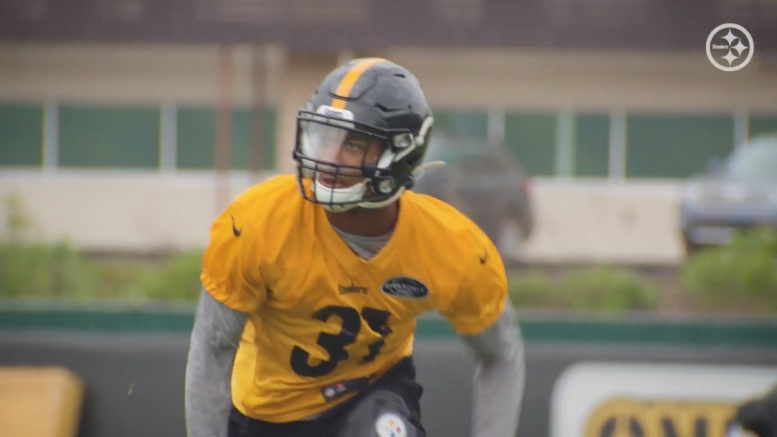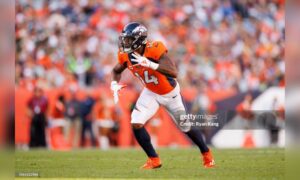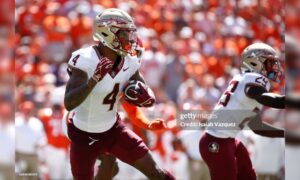With the recent losses of Mike Hilton via free agency and Steven Nelson via a cap crunch that inevitably led to his release, the Pittsburgh Steelers’ cornerback room appears to be short of proven commodities. The team still boasts the likes of Joe Haden and Cam Sutton, but Haden is getting long in the tooth and could be on the downward trend and Sutton is likely making a transition to more of an outside role in 2021 with questions lingering whether he will transition back inside on nickel and dime coverage looks.
Two years ago the Steelers invested a third-round selection in Justin Layne out of Michigan State, but many fans and analysts alike can look back on that pick and say they are still waiting to see if Layne can justify that selection. Given the need Pittsburgh has for one of their unproven younger CBs to step up in a big way in 2021, I wanted to dive into the limited action Layne has seen thus far and compare it to the likes of James Pierre who I also have posted an article on, and see if Layne should be the man the Steelers turn to for a bigger role on defense this upcoming season.
Here is my report on Justin Layne coming out of Michigan State in lead up for the 2019 NFL Draft:
Layne is a long CB prospect (6’2) that has long arms and a wiry frame. He is a former WR-turned defensive back that is relatively new at the position. Layne’s greatest attribute is his length, as he does well at battling contested catches by larger receivers in the red zone/jump ball situations. His length often makes up for average lateral quickness in tight window situations, as he often knocks passes away over the middle/ on the sideline with his long reach. Possesses solid speed for his size (4.5) but isn’t a burner by any means. Can tell he is still learning the position, as his backpedal doesn’t look very smooth and can be cleaned up along with crisper hip turns in coverage. Can be physical at the line in press man coverage, but he can get a little grabby and doesn’t always turn his head to locate the football when in the air. Can sometimes arrive too early at the catch point, likely resulting in more pass interference penalties at the next level. Appears to be comfortable in run support as a willing tackler, but often uproots ball carriers’ legs via dive tackling rather than wrapping up. Overall, Layne is raw as a corner prospect and needs development in terms of COD movement and tackling technique. However, his length and range allow him to be competitive in man coverage against large receivers. Layne has the prototypical size teams are looking for in outside corners, and his measurables, play style, and position change in college make Tre Flowers of the Seahawks an interesting pro comp. Layne should be targeted in the 3rd-4th Round as a developmental player who can become a solid starter in a year or two.
What stands out from this report after watching several games of Layne is that honestly, not much has changed in the guy’s play. For better or worse, whether it be the lack of play time or the speed of the game, Layne looks to be the same player he was with the Spartans that he is now in the league two years later. Let’s go to the film to explain what I mean. In the beginning of my analysis, I state that Layne’s greatest asset is his length, being a great option to defend combative catch situations given his height, length, and size.
He has examples of this in the pros, like on this play against Kansas City where he lines up against the TE split out wide in the red zone and breaks up the pass at the goal line, using his length to get his arm in-between the receiver’s hands to force the incompletion. He is close on his man the entire time and doesn’t give ample space to separate when condensed in scoring range.
We see another scenario here this past season against Washington where Layne lines up overtop the TE in the slot and does a good job getting hands-on with him off the snap of the ball, not allowing the TE to push off as he runs the short out route and stays on his back hip the entire rep, discouraging the passer from going his direction. Layne can be a good matchup with TE spilt out from the LOS having that side and functional movement skills to stay with them and not get bullied at the catch point like other smaller corners might.
Notice how I said “functional movement skills” above. While Layne isn’t a terrible athlete, his top speed isn’t great, and he isn’t the most fluid mover in a backpedal or when working laterally side-to-side. He gets turned around too easily in coverage, flipping over his shoulder rather than flipping his hips and being able to open up and run with a receiver. Case in-point here on this rep against Rashard Higgins of Cleveland where Layne is put on a spin cycle, being in good position to start playing Higgins toward the boundary, but then flips around over his shoulder rather than flipping his hips, exposing his back to Higgins who takes advantage and streaks up the sideline for the big chunk play downfield as Layne tries to play chase from behind, thankfully having Minkah Fitzpatrick come from deep middle to push Higgins out of bounds.
Take a look at this play against Baltimore where Layne is assigned to play Cover-3 on the deep right third of the field. He does a good job playing deep-as-deep, but when the receiver breaks back in to the open quadrant in-between the zones, Layne is still side shuffling back nearly ten yards from the receiver. The defensive front gets home on the play, but I would like to see more ability to click-and-close the space on the receiver underneath from Layne, as while he had deep third, he has shown that physically and well as mentally, he isn’t the fastest when it comes to putting his foot in the ground and changing directions.
Here in the same game against the Ravens, we see a lapse in coverage where Layne passes off the receiver he’s matched up with at the bottom of the screen with the slot defender, but fails to pick up the new receiver he switched on to, giving him separation on the inside and tries to pick up #89 Mark Andrews coming across the middle of the field when Marcus Allen already is running with him in coverage, hoping Allen simply breaks off his assignment and takes his man on the rub concept. Layne fails to communicate this to Allen, as both guys run with Andrews, leaving Layne’s receiver wide open in the middle of the field for the big chunk gain near the end of the game to put Baltimore into scoring range.
This is less of a physical mistake as it is more of a mental breakdown by Layne, not realizing that he needs to pick up his man past ten yards of the LOS and failed to communicate with the rest of the secondary about his intentions, leading to the bust in coverage.
Layne will also show his lack of confidence to transition to run vertically with receivers and mistrust in his own deep speed, often dropping back excessively in off-coverage and giving receivers a ton of space to work underneath. We see that on this rep versus Chris Godwin of the Bucs in preseason action, giving Godwin nearly ten yards of space to work underneath for the easy pitch-and-catch for the first down.
While Layne has the length and demeanor to come in and help in run support like I mentioned in his draft analysis, but he does rely on dive tackling and ankle biting far too often near the LOS as mentioned above. We see later in the same game against Godwin where he reacts to the quick pass behind the LOS and comes downhill, but leaves his feet and dives at Godwin’s ankles, unable to uproot him and knock Godwin off balance as Layne falls to the ground and Godwin jogs in for the score.
With that said, Layne has shown that his length can be an asset near the LOS in the same situation as we see on this rep against Washington. Layne reads the WR screen play on the left side of the formation and fights off the block of the receiver, wrapping up the WR as he catches the ball behind the LOS as other defenders rally to the ball to take him down for a loss on the play. This is a good example of Layne being able to react quickly to what is in front of him and use his length and aggressiveness near the LOS to his benefit for the positive play.
Here in the same game matched up with #17 Terry McLaurin, Layne does a good job in press coverage at the bottom of the screen, getting his hands-on McLaurin and successfully carries him vertically on the corner route concept, staying with him stride-for-stride as he runs into the area of the deep safety, essentially bracketing Washington’s #1 threat and taking him out of the play.
Overall, after watching more of Layne, I was able to see the traits that Pittsburgh was intrigued with coming out in 2019, having that frame and length you want in a starting corner on the outside. However, like I mentioned earlier, Layne hasn’t hardly progressed at all in his technique or situational awareness since coming into the league to be relied on confidently as a starter on the outside or in the slot. Sure, he could be a good matchup player for tight ends, But Devin Bush already essentially plays hat role and Pittsburgh also has Marcus Allen converting over to the LB position who serves the same purpose and offers more as a box defender against the run than Layne does.
Can Layne be a situational player that Pittsburgh uses in red zone situations with his length and ability to contest the jump ball? Yes. However, after watching him and Pierre in the same lens, my vote goes to Pierre getting the first crack at a larger role on defense, whether that be at outside corner should Sutton kick inside on nickel packages or with Pierre moving inside to the slot (which I highlight as a possibility in my article on him).
The fact of the matter is that Pierre has the same frame and length Layne brings to the table but possesses better movement skills in terms of hip fluidity and transitioning in coverage that we haven’t seen from Layne. Pierre also appears to be a more consistent wrap-up tackler than Layne making him a safer option. Throw in the fact that the likes of Arthur Maulet, UDFA Shakur Brown, and other young, unproven names on the team look to compete for spots on the roster this fall, and I would propose Layne may have a tougher time battling for a roster spot this season than competing for an elevated role on defense in 2021.
This is not meant to condemn Layne’s chances, but rather say based on his current film that the odds are stacked against him. Alex also did a great job highlighting the parallels that exist between Layne and recent Steelers flameout CB Artie Burns, as Layne also had a run-in with the law and was arrested at a traffic stop on April 23 for having a loaded weapon without a permit in the vehicle with traces of marijuana in there as well while driving on a suspended license. He ended up accepting a plea deal for community service and six months’ probation, but still not a great situation to be in as a third-year player trying to still establish himself on the team.
I hope he puts this, along with the inconsistent play in the past behind him to have his best season yet, but I have to personally say Layne is squarely walking the line of many of the recent Steelers drafted CBs who have seen their careers come to an end before they every really got going.
What are your thoughts on Justin Layne ahead of 2021? Do you think he’s in-line for an expanded role on defense, or do you think he should be relegated to more of a reserve role with other guys in the group getting playing time? As always, post your thoughts in the comments section below and thanks again for reading and your support of Steelers Depot!








